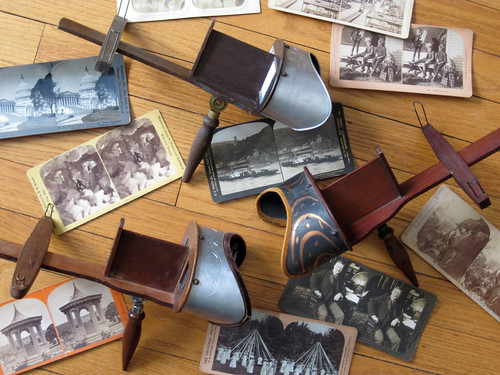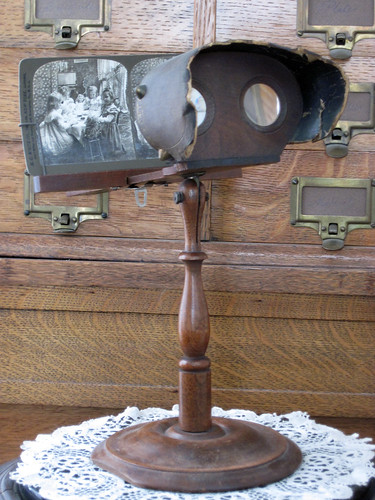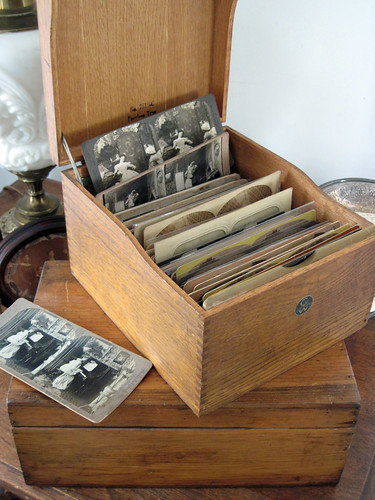The Victorian Stereograph
I began collecting stereoscopes and stereo cards, and whenever I saw a box full of them at an antique store or fair, I just had to look through the whole box. I collected all types of cards, and tried to find out as much as I could about their history. Stereography amazed me. Sure, I had Viewmasters when I was a kid, but I guess I was never impressed with the quality or the subject matter. Maybe I was drawn more to the Victorian stereo views because of my interest in both history and photography. Stereo cards were a very affordable way to collect early original photographic items, while peeking into an era long past.
First, a little history. Stereo photography came about not long after the dawn of photography itself. A stereoscope was on display at the Crystal Palace Exhibition in 1851, and Queen Victoria really took to the idea. Soon, stereoscopes became very popular in England. At first, they were made in the prevailing photographic medium, the daguerreotype. These were soon modified to become positive images on glass, and were viewed through Brewster stereoscopes, models with the light source coming from behind. In the late 1850's, Oliver Wendell Holmes invented a handheld stereoscope, which really took off in America. Paper card stereo views were produced from the early 1850's until the 1930's. Through the years, stereo views were made in almost every medium known to photography. Millions of different views were created throughout the world during the Victorian era.
From tabletop models, to backlit and handheld models, and even penny arcade models which stood on the floor and were loaded with hundreds of views to flip through, stereo photography was a hit. Every family had a viewer and some stereo views. Sets of stereo cards could be bought around different themes. The most widely successful theme was travel photography. The great stereoscopic manufacturers sent their photographers to all the corners of the world to bring back views. Other popular themes included comic views, natural and manmade disasters, the Civil War, exhibitions, and views of celebrities. Different types of stereographic cameras were also produced and perfected during this time. Stereo photography died out around 1930, then resurfaced in the 1950's when Viewmasters, Realist cameras and 3D movies were the rage.
What makes a stereo view appear so realistic? We have two eyes, and because our eyes are separated by a couple inches, we see a slightly different image with each eye. The brain melds these images into something we can understand. This separation of our eyes helps us to judge spacial relationships of different objects to each other, because we can see slightly around the objects. Sometimes things in the foreground are so close we have to almost cross our eyes so as to bring both images from each eye into focus. Things in the middle ground are easier to see, and we can tell what items are in front of others. Objects that are a great distance away appear flat because both eyes are virtually seeing the same image, and there is no depth perception. Stereographic photography takes advantage of the way our eyes see two slightly different images. Two photographs are taken, one slightly to the right or left of the other. These images are mounted and viewed with a special viewer that allows the left eye to see one picture and the right eye to see the other. Your brain fuses these images together, just as it would if you were viewing the images live, and you get the effect of seeing the image as if you were really there.
In my next post, I'll talk more about the different types of Victorian stereo cards in my collection, and show you how to make and view your own stereographs!
Labels: Entertainment, History, Photography





12 Comments:
Fantastic post. I adore posts that provide insight into old things and this is wonderful. I, too, have a pair of steroptics and enjoy viewing through both of them. Additionally, did you know that the viewing cards are supposed to be curved? Many people think this is from old age, it is not, they are curved for the very purpose of providing an enhanced 3-d illusion. Can't wait to see your photo cards in a future post. Sea witch
Hi Sea Witch-
Yes, the curved card mounts were invented in the late 1870's by B. W. Kilburn, and soon became the industry standard! Thank you for visiting , and for your wonderful comments. I could go on and on about my love of stereo photography! :)
-Pam
I read that article in Victorian Homes too! I love the history you provided and the wonderful pictures of your collection. I can't wait to learn more!
Blessings,
Kim
OMG, what a wonderful history you provided! I bought a stereoscope about a year or so ago and have been collecting cards for it. Most of my cards are of distant lands which I had read Victorians enjoyed. I also have a Worlds Fair and some humorous ones of husbands and wives of the era. They are so much fun! I keep them in my guest bedroom so that anyone who visits may enjoy viewing them. And thanks to the Seawitch - I now know why they are curved! Great post!
WOW!! I haven't seen those in years. Glad you posted it for the young ladies. I bet they haven't seen it.
yvonne
Kim-
I think I may need to do two more postings on the subject — there is so much to cover!
-Pam
Sweetbrier-
I think the views with people are the best, because I love the clothing! But I really enjoy a lot of the cards from distant lands as well, especially of buildings that don't exist anymore, or something that has changed a lot since those days. What a wonderful idea to keep them in your guest room! :)
-Pam
Yvonne-
I think in more recent years, these things are getting harder to find. I wish that everyone who was interested could afford to pick up a antique viewer and some cards, if they could find any!
-Pam
oh Pam, what a fabulous post! I enjoyed reading it so much, and seeing the pictures of your delightful collectibles! My mother often talked about using one to view pictures and how much fun they were. She always regretted the loss of it over the years, not knowing where her grandfather's had landed. this post made me think of my Mom! So thanks for a double pleasure today. hugs from a sunny blue skied germany today, debby
His Debby-
The sun is out and the sky is blue here today, too! I smell Spring in the air!
Too bad your mom's stereo viewer went missing before you could use it. But there are companies making modern versions! That will be part of my upcoming posts about this subject.
Take care!
-Pam
What a Fabulous Blog! I am finding that I like history too, especially local history and how the past influences the present. I'm loving your amazing photos, I'm a detail fanatic and a stitcher, so have a few antique Christening gowns with wonderful detail on them. You inspire me to look more into the historical side of my city. Thanks!
Welcome, kiwidutch!
Thank you for the nice comments. Your life and blog look amazing, and I'll have to read more about your travels and ideas. I love to see how people in other countries live!
-Pam
Post a Comment
Subscribe to Post Comments [Atom]
<< Home